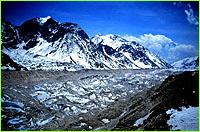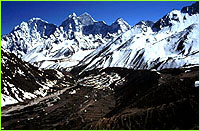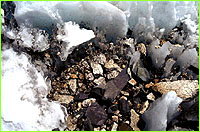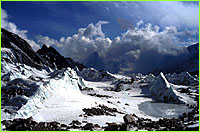 |
 |
 |
 The Anatomy of a Glacier
The Anatomy of a Glacierpart 3 | back to part 2 Moraines "Geologically, the Khumbu Icefall sits in a vast amphitheater of rock. Where the mountaineers only see mountains, geologists see a remarkable absence of rock. The mountains are relics of a collisional process. The glaciers have literally removed the mountains, rock by rock, and have taken them down to rivers, which have transported them to the sea. And the quantity is extraordinary. Approximately nine-tenths of the Himalaya has gone, and what's left are these puny little peaks which of course are the targets of all these mountaineers' attempts at glory."—Roger Bilham  In the process of advancing and retreating, a glacier carves, reshapes and striates the land beneath
it. As it moves, a glacier collects and carries along everything from dust particles up through
giant stone boulders. The boulders at the front of the glacier gouge the valley floor, carving
it into a U-shaped trough. There are also large rocks beneath the glacier, which get left behind
on the valley floor after the glacier has retreated. These rocks are divided into two types:
smoothly rounded humps of rock and clay, called drumlins, and eroded outcrops of very hard rock,
called roches moutonnees, which means sheep rocks.
In the process of advancing and retreating, a glacier carves, reshapes and striates the land beneath
it. As it moves, a glacier collects and carries along everything from dust particles up through
giant stone boulders. The boulders at the front of the glacier gouge the valley floor, carving
it into a U-shaped trough. There are also large rocks beneath the glacier, which get left behind
on the valley floor after the glacier has retreated. These rocks are divided into two types:
smoothly rounded humps of rock and clay, called drumlins, and eroded outcrops of very hard rock,
called roches moutonnees, which means sheep rocks. The base of the glacier goes by several names, including terminus, snout and toe. Moraine—smaller rocks and soil—are deposited at the terminus of the glacier.  Moraine is also deposited on either side of the glacier. This type of moraine is called lateral
moraine.
Moraine is also deposited on either side of the glacier. This type of moraine is called lateral
moraine.When two glaciers merge and end in one terminus, a swath of moraine can be seen running down the center of the glacier. This type of moraine is called medial moraine. Glaciers and Weather Seasonal changes in climate have an impact on glaciers, contributing to their melting or refreezing. This, in turn, determines whether a glacier is in the process of advancing (moving downhill) or retreating (melting). The reverse is also true: glaciers have an impact on weather.  The sharp contrast between the frigid air around the poles and the warmer air around the equator
sets up a temperature differential that results in the giant jet streams of wind that circle the
planet, and also relates to storm development.
The sharp contrast between the frigid air around the poles and the warmer air around the equator
sets up a temperature differential that results in the giant jet streams of wind that circle the
planet, and also relates to storm development.Jean Monahan has produced content for various forms of interactive media since 1990. She wrote or co-wrote many of the NOVA features on the PRODIGY service, and has created several "Hot Science" sections for NOVA Online. Lost on Everest | High Exposure | Climb | History & Culture | Earth, Wind, & Ice E-mail | Previous Expeditions | Resources | Site Map | Everest Home Editor's Picks | Previous Sites | Join Us/E-mail | TV/Web Schedule About NOVA | Teachers | Site Map | Shop | Jobs | Search | To print PBS Online | NOVA Online | WGBH © | Updated November 2000 |